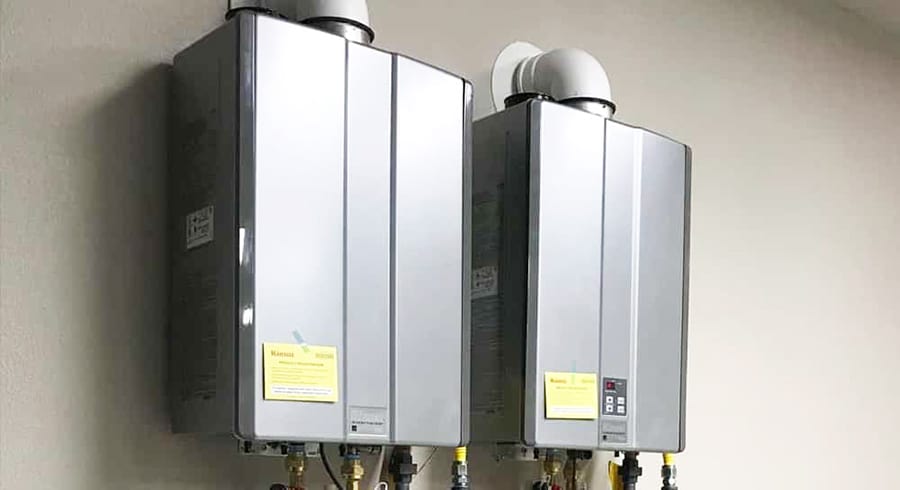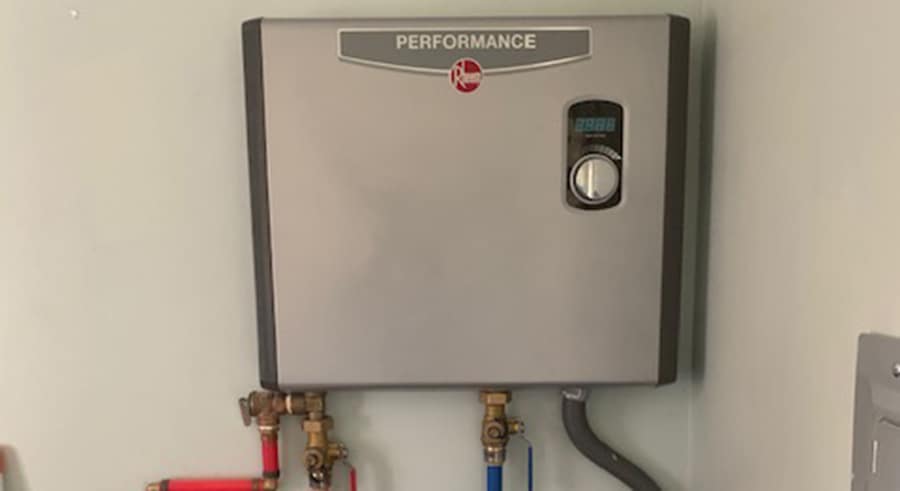
When purchasing a tankless water heater, you should know that interior and exterior models are available. The main difference between the two models is how they are vented. Venting of gas tankless water heaters is often a question among buyers.
Exterior gas models have vents along the unit’s front, which is not suitable for interior use. If you’re not careful, you may purchase the wrong size tankless water heater for your family’s needs. So, what about interior models? Do tankless water heaters need to be vented?
Indoor gas tankless water heaters need to be vented. All indoor models have an exhaust vent. Indoor models also need a fresh air intake either from a direct vent or a power vent. Direct vent models draw fresh air from outside and can be installed in small spaces. Power vent models draw in fresh air from the surrounding interior space and need to be installed in a larger area with enough air quantity for combustion.
Gas tankless water heaters installed outside have built-in vents across the unit’s front and don’t need additional vent piping. Electric tankless water heaters do not require venting regardless of where you install them.
Ensuring that tankless water heaters have been properly ventilated is essential for installing the unit safely and functionally. The lack thereof could potentially lead to carbon monoxide poisoning, which is extremely harmful and potentially fatal.
We’ve gathered the most influential factors to consider, which should always be used as a guide following manufacturers’ instructions. Stick around to find out how you should go about establishing a safe and efficient setup for a tankless water heater.
Tankless Gas Water Heaters that Need to be Vented
Tankless gas or propane water heaters are absolutely fantastic for efficiency as they can reduce energy by up to 50%, in addition to the major bonus of it reducing greenhouse gas emissions by up to 61%. But, they do need to be vented properly to achieve such efficiency and functionality in addition to safety requirements. The type of intake venting largely determines where tankless water heaters are installed; direct vent or power vent.
All gas tankless water heaters need to be vented effectively, whether fueled by natural gas or propane. They can be vented through an exterior sidewall or roof; however, you need to take the shortest route possible. Tankless water heaters can terminate on a sidewall as a result of the combustion fan exhausting horizontally.
A special stainless steel vent pipe is used for tankless water heaters that won’t damage from venting corrosive gases. The standard galvanized vent used from tank water heaters, or furnaces will rust quickly when venting a tankless heater.
Insider Tip: Tankless water heaters can not share a vent with a furnace or use a chimney flue for venting. The acidic exhaust gas produced will rust away standard galvanized flue piping and masonry chimney liners.
Tankless water heaters with a 5-inch concentric vent design contain both intake and exhaust venting pipes. The vent design keeps the vent cool because the warm exhaust vent is insulated inside. This also adds a layer of protection from harmful gasses. The concentric vent keeps harmful gasses from entering the home if the exhaust pipe inside starts leaks.
Many manufacturers offer recess boxes for recessing the non-condensing tankless water heaters inside the wall framing instead of hanging off the wall. Pipe covers can add an appealing aesthetic design to the system and improve the system’s appearance.
Having the freedom to install venting through a sidewall is far more convenient and cost-effective than venting through to the roof, such as with many traditional gas water heaters, as long as plumbing can accommodate the positioning.
Although they can freeze in cold climates or areas which experience electric outages, tankless water heaters are resilient to freezing through built-in freeze protection, making it possible to install them outside in warmer climates.
Tankless water heaters installed outdoors do not need to be vented, making this a suitable and convenient option for those who live in suitable conditions.
While non-condensing tankless water heaters are smaller and compatible with most recess boxes at an average size of 14 inches in width, condensing boxes larger at around 18 inches in width have many benefits.
Condensing tankless water heaters are approximately 95% more efficient than non-condensing types, which only transmute around 80% of the heat generated to the water, leaving residual heat, which leads to hot exhaust gas. This means that the exhaust of a condensing tankless water heater is cooler at around 110° to 120° F.
The lower temperature impacts the necessity for costly metal ventings such as stainless steel needed to withstand higher temperatures created by non-condensing types and allows the utilization of more cost-effective materials such as PVC or polypropylene.
Tankless water heater venting is most efficient when installed with a slight slope from the heat exchanger and condensate from the drain near the exhaust, which prevents drainage back into the heater and prolongs the lifespan of the unit.
Tankless Water Heater Vent Types
There are various types of vents for tankless water heaters, all of which have varying functionality, pricing brackets, spatial requirements, and advantages. The most suitable vent would be highly dependent on the tankless water heater’s positioning and its size, the necessity for air intake, and spatial requirements.
Power Vent
Power vent units utilize air found indoors for combustion and work by exhausting the air outside for regulation. As a result of this functionality, power vent units only need one exhaust vent. With the concern of spatial limitations in the immediate environment, these units require a larger space where sufficient air is available.
Direct Vent
Direct vent units have two vents, one of which functions for intake by pulling air into the building from the outside and exhausting air. Direct vent units have two vents and utilize outside air for their functionality.
Direct vent units can be installed in smaller areas, like closets, with less excess air in the immediate environment. This saves up to approximately 16 square feet of space, making them an excellent choice if the spatial limitation is concerned.
Concentric Vent
Concentric vents are 2 vents in 1; a single vent that actually contains both intake and exhaust direct-vents. Manufacturers commonly offer concentric vents to achieve the best qualities of both power vent and direct vent units.
Concentric vents provide the functionality of having one pipe, which comprises an exhaust vent and a direct intake vent. This means one hole in the sidewall or ceiling and the fact that temperatures are regulated as warm exhaust air remains inside, which keeps them cool to the touch.
This means that the tankless water heaters require less surface clearance when installing. Concentric vents are not hot to touch like direct vents. In addition to such benefits, concentric vents are far safer, as the exhaust air is contained, preventing leaking harmful gases into the home.
While they do provide plenty of advantages for safety and convenience, it should be noted that concentric vents are larger, and pipes are generally around 5 inches in diameter, as opposed to a standard 3 inches for single pipes.
When it comes to ensuring that your tankless water heater is properly vented, there are quite a few options and approaches that all award varying benefits and are suitable for varying budgets and scenarios.
Having an efficient venting system is crucial for ensuring safety, functionality, and comfortability within the space. Your approach for establishing a proficient venting system should always be considered following manufacturers’ guidelines and professional recommendations.
Can a Tankless Water Heater and Furnace Share Venting?
Tankless water heaters can not share a vent with a furnace or any other appliance. As we discussed earlier, tankless units produce a highly acidic gas that will rust standard galvanized vent pipes. A stainless steel vent is well suited to handle the venting for gas tankless water heaters.
However, modern common-venting systems utilize manifolds to share the same exhaust and intake vents for up to eight tankless units. This is great for installing multiple tankless heaters without adding additional permeations in the building’s structure but should only be installed if it’s determined to be a suitable option by an experienced professional.
Can You Use the Existing Vent for the Tankless Water Heater?
For the same reason you can’t vent a tankless water heater with a furnace, you won’t be able to use the existing vent pipe from an old gas tank water heater. The existing vent for tankless water heaters is not compatible because most are galvanized vent piping and will rust quickly. Special stainless steel pipes should be used for venting unless plastic materials are suitable based on the vent manufacturer’s guidelines.
Do Electric Tankless Water Heaters Need to be Vented?

Unlike gas or propane tankless water heaters, electric tankless water heaters do not need venting . Electric tankless water heaters use electric burners to heat water rapidly. Since no natural or propane gas is used, no venting is needed. This efficiency, convenience, and overall suitability are some of the most influential factors in the growing popularity of electric tankless water heaters.
Since no venting is required for electric tankless water heaters, they do not lose as much heat as their gas counterparts. This makes electric tankless water heaters more cost-effective and far more proficient, with approximately 99% efficiency instead of an average of 80% – 85% efficiency for gas tankless water heaters.
The drawback of electric models is that they require a 240v circuit for each burner. Many models will require two or even three 240volt breakers, meaning you’ll likely need to update your electrical service or add a separate subpanel just for the electric tankless water heater.







